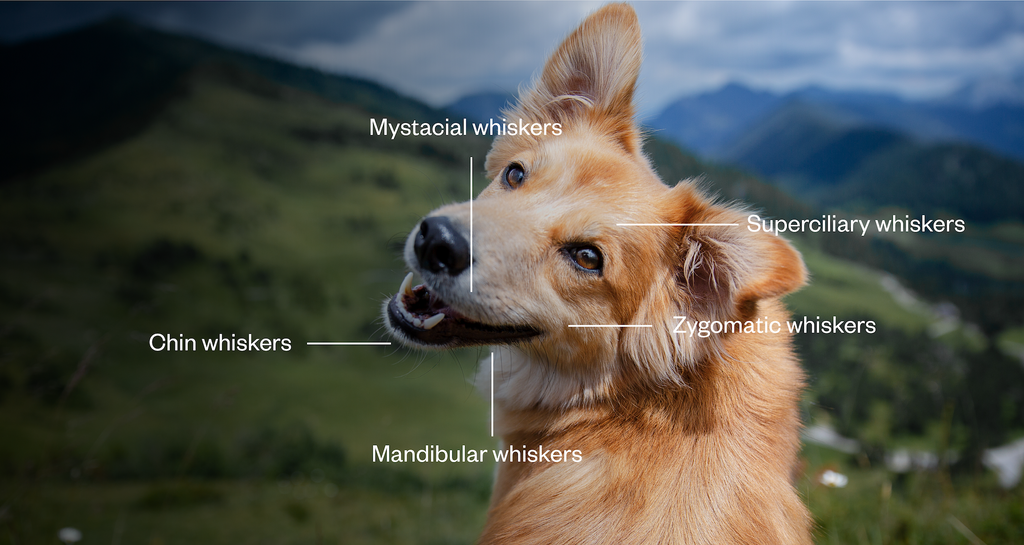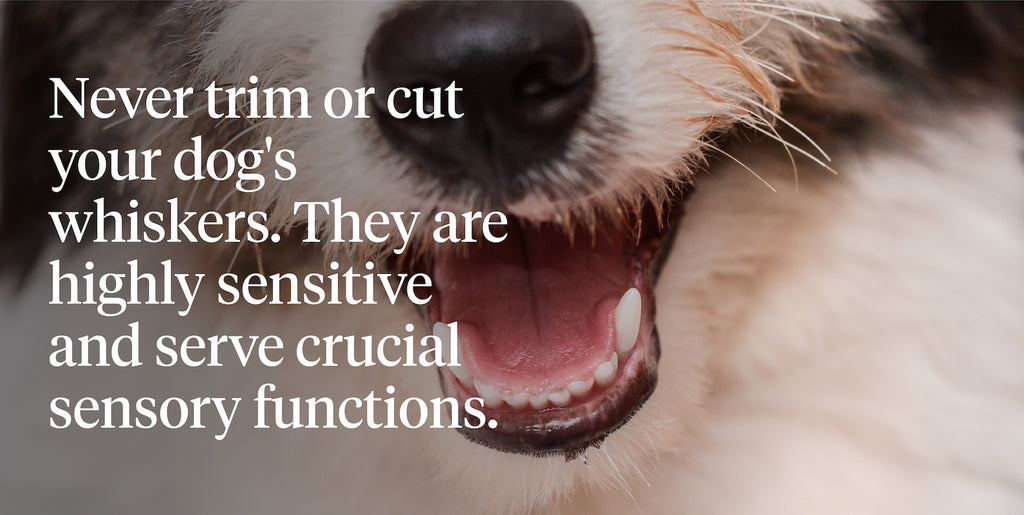9 Min Read
Why Do Dogs Have Whiskers?
Key takeaway
Dog whiskers play several key roles in your dog’s sensory input. As a pet parent, it’s important to know what whiskers do and how to care for them. You should avoid trimming and touching your dog’s whiskers too much. Keeping your dog’s whiskers in good shape can help them live a happy, healthy life.

Why pet owners are switching to online vet care with Dutch
-
Prescriptions delivered free to you
-
Fast access to Licensed Vets over video
-
Unlimited video visits and follow-ups
Why do dogs have whiskers on their cheeks? Why do some dogs have whiskers in odd places? These are questions a lot of pet parents ask, and the answers might surprise you. Whiskers aren’t just cute — they play essential roles in dogs’ daily lives.
Your dog uses their whiskers to sense objects around them, express emotions, and figure out how close they are to objects. While there are no actual nerves or feelings in whiskers, they provide several essential functions for dogs. There are also lots of nerves in the follicles that whiskers grow from, which can make them sensitive.
Just like cat whiskers, dog whiskers need to be protected. Want to learn more about dog whiskers and what they’re used for? Keep reading!
- What Are Whiskers?
- Where Do Dogs Have Whiskers?
- Reasons Why Dogs Have Whiskers
- Do Dog Whiskers Shed?
- Dog Whiskers: Safety & Care
- Why Do Dogs Have Whiskers?: FAQs
- Final Notes
What Are Whiskers?

Whiskers are a special type of hair that’s found on the faces of cats and dogs. These hairs are called vibrissae, and they’re much thicker and coarser than the hair on the rest of your dog’s body. The roots of vibrissae are also deeper, and the follicles that the hairs grow from have a high concentration of blood vessels and nerves.1
The unusual structure of whiskers and their follicles makes them more sensitive than regular hairs.1 This is why it’s so important to be careful with your dog’s whiskers.
Where Do Dogs Have Whiskers?

Dog whiskers vary a bit from pet to pet — and they can be hard to spot in shaggy dog breeds — but whiskers typically grow on the face. Most dogs have whiskers around the muzzle and on the cheeks. Some dogs grow whiskers in other regions of the face as well as the chin and neck.
Why do dogs have whiskers above their eyes in some cases? These whiskers are known as superciliary vibrissae, and they play an important sensory role. Eyes are sensitive, and whiskers can help protect them.
There are different names for each different type of whisker. Mystacial whiskers are below the nose, while zygomatic whiskers are located on the cheeks. The whiskers on your dog’s chin are called chin vibrissae, while the lower jaw whiskers are called mandibular whiskers.
Reasons Why Dogs Have Whiskers
Sensory Perception
Sensory perception is one of the most important functions of dog whiskers.2 Your dog’s whiskers can sense vibrations and changes in air currents that help them get around even when they’re dark or in an unfamiliar area. You might notice your dog moving and repositioning their whiskers when they sense a threat.
Object Detection
When your dog touches something with their whiskers, they know there’s an object close by.2 Dog whiskers can even relay information about the object to your dog, especially the size of the object. Being able to detect objects is a key function for dogs when hunting prey, but it’s also useful when your dog needs to crawl into or through a tight spot.
Proximity Measurement
Dogs also use their whiskers to figure out how close objects are.2 This helps your dog know where they’re going and avoid objects when walking around. Dogs use proximity measurement every day, whether they’re navigating your backyard or going from one room to another. If there’s an object too close or in the way, your dog can move out of the way to protect themselves.
Emotional Expression
Just like we show physical signs of our emotions, dogs can show emotions through their facial expressions and whiskers.3 Dog whiskers highlight the eyes and mouth, emphasizing the faces your dog makes and giving them more personality.
Dogs can also use their whiskers to give us important cues about their physical state. For example, a sustained raising of their eyebrows coupled with other signs like pulled back ears can indicate mild pain in some cases.3 Always pay close attention to your dog’s expressions and any changes in behavior. Contact a vet as soon as possible if you think your dog is feeling unwell or in pain.
Protection
Whiskers play a huge role in protecting your dog on a daily basis. The whiskers near the eyes tell your dog to close their eyes in the presence of dust and other threats. The whiskers around the muzzle help your dog feel tall blades of grass, thorns, and other obstacles around the yard. When your dog senses danger with their whiskers, they can safely move away before they’re hurt.
Dogs’ eyes are extremely sensitive, so the superciliary whiskers (above the eyebrows) are especially important. Even something as small as a particle of dust or a tiny piece of dirt can cause damage to the eyes.
Do Dog Whiskers Shed?
Just like the rest of the hair on your dog’s body, whiskers shed. Your dog will occasionally shed their old whiskers and regrow new whiskers. This is a normal part of the maintenance process, so don’t be alarmed if you notice loose dog whiskers lying around the house. Excess shedding may be caused by a medical condition that leads to hair loss in dogs, so take your dog to the vet if they lose a significant amount of hair or whiskers.
Dog Whiskers: Safety & Care

Do Not Trim Whiskers
While dog whiskers will shed on their own over time, you should never trim them yourself.1 Your dog relies on their whiskers to navigate and perceive the world around them, so trimming their whiskers can leave them feeling disoriented. The length of whiskers plays a key role in proximity measurement and object detection, so don’t trim your dog’s whiskers even if they look too long.
Avoid Whisker Fatigue
Whiskers are basically sensors for dogs, and they don’t like when those sensors are constantly going off. Whisker fatigue is caused by whiskers rubbing up against an object repeatedly, and it’s a common problem with certain food bowls. A food bowl with lower walls is one of our favorite dog essentials for preventing whisker fatigue. A low food bowl won’t rub against your dog’s whiskers, so they can eat for as long as they want without whisker fatigue.
Protect Whiskers From Damage
Your dog’s whiskers are sensitive — and not just to touch. Whiskers can be damaged when they’re pressed tightly against an object, and that can affect your dog’s ability to navigate and sense objects. Avoid tight collars, harnesses, and muzzles that may cause the damage to whiskers. If you’re not sure how a collar or harness is supposed to fit, your vet can help you choose the right size for your dog.
Why Do Dogs Have Whiskers?: FAQs
Can I touch or play with my dog's whiskers?
You’re not going to hurt your dog by gently touching their whiskers, but it’s important to keep in mind that whiskers are sensitive. You can gently touch your dog’s whiskers when you’re giving them pets or scratches, but avoid touching them too much to prevent whisker fatigue. Overstimulating your dog can stress them out, and stress can be harmful in several ways. You don’t have to avoid touching your dog’s whiskers altogether, but you shouldn’t do it more than you have to. Some dogs love having their chin or cheeks scratched, and there’s nothing wrong with that as long as it doesn’t seem to stress your dog out.
Are dog whiskers similar to cat whiskers?
Dog whiskers are very similar to cat whiskers. In fact, dogs and cats use their whiskers for the same types of sensory purposes. Cats and dogs both use their whiskers to navigate and perceive their environment, which includes sensory perception, object detection, and proximity measurement. The biggest difference between dog whiskers and cat whiskers is the placement. Dogs can grow whiskers in various parts of the face, and there’s no real pattern to dog whisker growth. Cat whiskers grow in a neatly arranged pattern on one part of their face. Whether you have a cat or dog, the same rules apply when it comes to touching and trimming whiskers.
Do puppies have whiskers?
When puppies are just born, they have the whisker follicles that eventually grow into full-size whiskers. Puppy whiskers start out very short and thin, but they continue to grow over time as your puppy grows. Once your puppy is a few weeks old, their whiskers should be well-established.
When puppies are very small and haven’t opened their eyes yet, they use their whiskers when it’s feeding time. Puppies use their tiny whiskers to find their moms to get milk, because they can’t see to know where they’re going.
How many whiskers do dogs have?
While cats have an exact number of whiskers, that’s not the case when it comes to dog whiskers. Some dogs have a small concentration of whiskers on the muzzle and above the eyes, while other dogs also have whiskers on their cheeks, chin, and lower jaw. Dogs grow whiskers in different places just like humans have different hair — it’s part of what makes them unique. As long as your dog has whiskers on their muzzle and above the eyes, they have the sensory tools they need.
Generally speaking, dogs have somewhere in the area of 20-30 whiskers.
Do dog whiskers grow back?
Whiskers will eventually grow back just like regular hair does, so you don’t have to worry if you notice your dog lost a whisker or two. That being said, you should never trim your dog’s whiskers — even if they look a little too long. Whiskers take a lot longer to grow back compared to regular hair. If your dog sheds a whisker, it can take anywhere from a few weeks to a few months for that whisker to grow back.

Final Notes
From dogs and cats to reptiles and more, there are so many things pet parents can learn about their pets. The more you know about your pet and their anatomy, the better you can take care of them. A little knowledge about whiskers can help you keep your dog safe and stress-free.
When you need help taking care of your furry friend, Dutch is here for you. With vets available via video call and an online pharmacy, Dutch helps you take better care of your pets from the comfort of your home. Try Dutch and see how much simpler vet visits can be when you can get help online.Share
References
-
Doring, Dorothea. et al. "The importance of the tactile hairs in domestic dogs and the problem of trimming these from an animal welfare perspective." Tierärztliche Praxis Kleintiere. Jun 18 2020. https://pubmed.ncbi.nlm.nih.gov/32557495/.
-
Luo, Yifu and Hartmann, Mitra J.Z. "On the intrinsic curvature of animal whiskers." PLoS One. Jan 6 2023. https://www.ncbi.nlm.nih.gov/pmc/articles/PMC9821693/.
-
Mota-Rojas, Daniel. et al. "Current Advances in Assessment of Dog’s Emotions, Facial Expressions, and Their Use for Clinical Recognition of Pain." MDPI Animals. Nov 22 2021. https://www.ncbi.nlm.nih.gov/pmc/articles/PMC8614696/.



